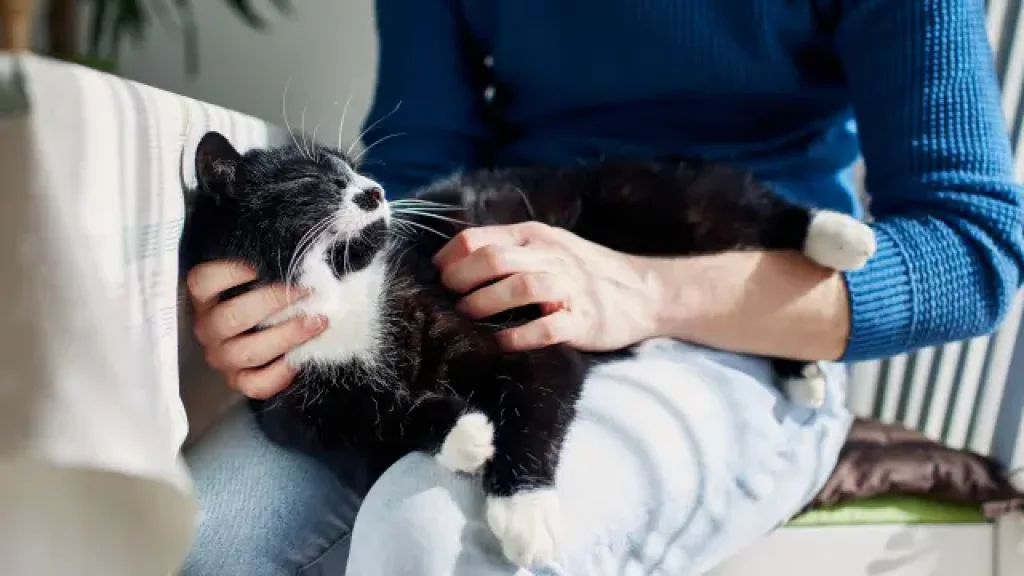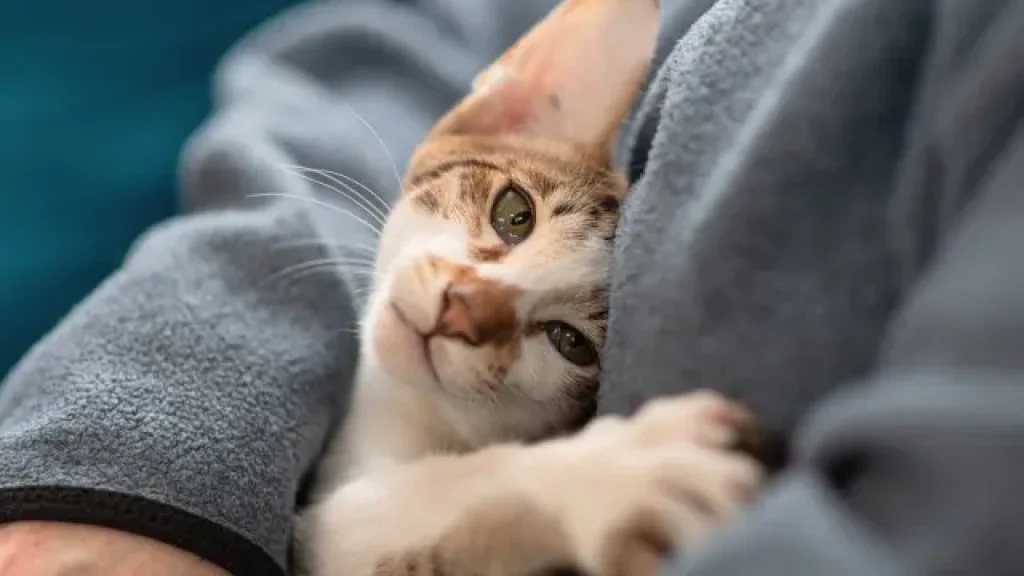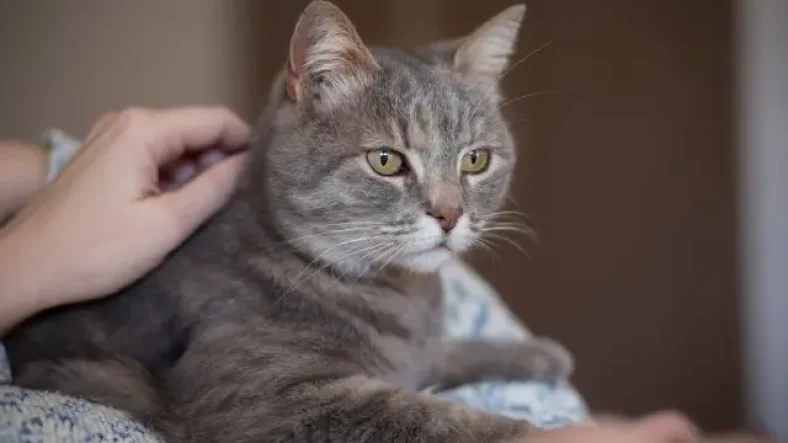Are you saddened by your cat’s recent lack of affection? Don’t worry – you can reignite the bond and get them purring in your lap once more!
To help you, we’ll look at why your beloved feline may have changed its attitude towards you, signals they might use to show their love, and easy techniques to foster a loving relationship.
With a bit of attention and patience, who knows – you could see that beautiful bond reborn. So, what are you waiting for? Let’s start on the journey to restore your special connection with your furry friend!
Contents
Understanding Your Cat’s Behavior
Gaining insight into your cat’s behavior and emotions is key to developing a loving relationship. To make your feline friend adore you once more, it’s paramount that you comprehend the fundamentals of cat psychology, communication, and body language.
Felines communicate their sentiments through vocalizations such as meowing or hissing, yet they also employ non-verbal cues like facial expressions and postures. Having an appreciation of these signs can assist in deciphering what your kitty is feeling at any given period.
It’s likewise vital to recognize that cats have distinctive characters. Some may be more fond due to their exclusive temperaments and experiences with people. With this wisdom in mind, we can proceed towards constructing an everyday routine for your pet that will nurture trust and strengthen the bond between both of you.
Establish A Routine
Creating a consistent routine is essential for creating a strong bond between you and your cats. Set mealtimes, plan fun playtime activities, provide yummy treats as rewards, and ensure they have plenty of space to retreat when they need it.
Showing appreciation for their individual needs and honoring their natural behaviors will reward you with lots of love in return!
In order to reestablish trust between yourself and your feline friend, it’s important that you spend quality time together on a consistent basis; this could be anything from brushing their fur while talking softly or taking them out for walks if possible.
Showing them kindness and patience are essential steps in helping rebuild that special connection with your beloved pet once again.
Spend Time With Your Cat

Did you know that cats, on average, spend 5-8 hours a day sleeping? That leaves plenty of time for cat-human interaction. To make your cat love you again, it’s important to dedicate quality time to them and create an environment where they feel relaxed and content.
Start by creating a few special bonding activities specifically designed with your cat in mind. These could include cuddles or brushing their fur while speaking gently to them.
It may be helpful to introduce some entertainment ideas such as toys, scratching posts, window perches, and even interactive food puzzles; this will help keep your cat entertained and stimulated whilst providing opportunities for physical activity too.
Try introducing other pets into the home if possible – cats are social animals who prefer living in groups, so having another friendly feline companion can really help improve their overall well-being.
Finally, it’s essential that you provide a safe space for your kitty at all times, which is free from stressors like loud noises and unfamiliar people entering the home.
Allowing your pet access to natural sunlight also helps encourage healthy habits like grooming themselves regularly and taking regular naps throughout the day.
This type of setup encourages a more secure bond between yourself and your furry friend, something that’ll grow stronger over time when playtime and interaction become part of your daily routine!
Playtime And Interaction
Once you have started spending time with your cat, it is important to engage in playtime and interaction. Interacting with your cat can include a variety of activities, such as playing catch with a small toy or providing them with interactive cat toys that they can use on their own.
Choosing the right type of toy for your particular cat’s needs is essential, so make sure to look into what kind of activity will be most suitable for them. Rewards such as treats are great incentives for cats to participate in playtime and interaction.
This positive reinforcement helps create an environment where both you and your cat will feel comfortable engaging in activities together.
Take some time to explore different types of toys and activities that may help strengthen the bond between you and your cat. Creating a safe space for your furry friend is the next step towards making them love you again.
Create A Safe Space For Your Cat

To give your kitty a safe haven of their own, provide them with a secluded area that’s both calming and comfy. Equip it with items from their favorite toy box, scratching posts, sunlit windows, cozy beds – whatever will make them feel like home.
Keep the atmosphere as tranquil as possible by avoiding loud noises or quick movements that could startle your kitty.
Take care to block off any potential hazards such as exposed wires, cables, or toxic plants. If done right, you’ll have built an exceptional sanctuary for your feline friend where they can truly feel at peace and content.
It’s important to recognize when your kitty is displaying behavior that shows comfort within their new safe-cat-environment. Praise them for spending time there with positive reinforcement like treats or petting sessions; this lets them know that being in the secure cat area brings good things – thus making it a regular destination of theirs.
Never punish cats inside their own cat comfort zone because doing so will lead to anxiety which could ruin the progress you’ve made building up this feline sanctuary.
In order to ensure success in forming a strong bond between yourself and your pet companion again, start by creating an inviting atmosphere full of safety and security for them to reside comfortably.
Reward Good Behavior
Research shows that 80% of pet owners utilize positive reinforcement and rewards-based training to foster desirable behaviors in their furry friends. This makes it essential to comprehend how rewarding your cat can help you rekindle the love.
Through offering treats, toys, or even Showing extra TLC such as brushing his fur or cuddling up together, he’ll eventually come to terms with the fact that good behavior means something special from you – Which will result in him feeling content when spending time with you!
If the rewards remain consistent, he may even look forward to being around you in anticipation of what riches await!
Of course, some cats might be more difficult than others and require more precise techniques when it comes to teaching them new behaviors. In these cases, it could be helpful to consult an expert, if necessary, who can provide additional guidance on how best to train your particular furry friend.
Doing so can ensure that both of you have a happy life together once again. Moving forward into the next section about consulting an expert…
Consult An Expert If Necessary
If you have tried all the tips mentioned before and your cat still isn’t responding as desired, it may be time to seek professional help. A qualified cat behavior specialist or feline behaviorist can provide advice tailored to your situation.
The best way to get started is by consulting a veterinarian that specializes in cats or talking with a local humane society about a referral to an experienced cat specialist.
A trained consultant will review your particular circumstance and evaluate any underlying issues while providing guidance on how to address them. They might suggest specific techniques such as clicker training, play therapy, positive reinforcement methods, scent-marking protocols, or other approaches based on their expertise.
By addressing the primary cause of the problem rather than just treating symptoms, they can help resolve behavioral issues quickly and effectively.
The key is finding the right expert for you and your pet — someone who understands both felines and humans alike — so don’t rush into anything without doing research first.
Seek out reviews from previous clients online or ask friends for recommendations if possible; then schedule an initial assessment appointment with the person that seems like the best fit for both you and your cat’s needs.
With patience, dedication, and some professional assistance from a knowledgeable cat behavior consultant or feline behavior specialist, you should soon find yourself back on track with your beloved furry companion.
Frequently Asked Questions
Q: My cat used to love me but now seems to hate me. What can I do?
A: Cats can surprise you with their behavior shifts, which can occur for a variety of reasons. Taking a step back to assess the changes in environment or routines they may have experienced is essential.
Seeking the help of a veterinarian should be your first priority when attempting to uncover any potential health issues as the root cause.
Once you have a grasp on what’s happening, attempt to rebuild trust and fondness through shared experiences that are accompanied with positive reinforcement techniques.
Q: Can I make my cat love me if they don’t like other people?
A: Yes, it’s possible to build a loving relationship with your cat, even if they are generally wary of people. Start by creating a safe space for your cat and providing them with a routine that fosters a sense of security and consistency.
Spend time with your cat and engage in bonding activities, like playtime or brushing their fur. Use positive reinforcement techniques to reward good behavior and build trust over time.
Q: My cat is aggressive towards me. What should I do?
A: Aggression in cats can be caused by many things, including fear, stress, or territorial behavior. It’s important to identify the cause of the aggression and seek professional help if necessary.
In the meantime, avoid any behaviors that may trigger your cat’s aggression and provide them with a safe and calm environment.
Consult with a veterinarian or a cat behavior specialist for guidance on how to handle aggressive behavior in your cat.
Q: Can I train my cat to love me?
A: You can’t train a cat to love you, but you can build a strong bond and establish trust through consistent and positive interactions.
Spend quality time with your cat, engage in bonding activities, and use positive reinforcement techniques to reward good behavior.
With patience and dedication, you can create a loving relationship with your furry friend.
All Things Considered..
It can be heartbreaking when we feel like our special feline friends don’t want to be around us. Don’t forget, cats are sensitive creatures and sometimes struggle to show us their true emotions. However, armed with patience and empathy, it’s easy to build a strong, loving bond again.
Start by recognizing their stressors. Have you noticed any changes in their behaviour – such as hissing or aggression, or avoiding contact? Try providing your kitty with extra hiding spots, scratching posts and a calm environment.
Secondly, use rewards when they display desirable behaviour, rewarding them with treats and affection. Enable your buddy to rely on you by feeding them regular meals at the same time each day and having fun together.
Put the effort in and you’ll soon have a devoted companion again!
Show some understanding towards your furry friend and shower them with lots of love – it will make all the difference in strengthening the relationship between you two!


